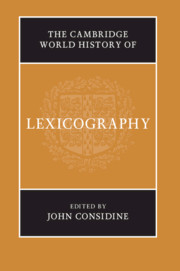Book contents
- The Cambridge World History of Lexicography
- The Cambridge World History of Lexicography
- Copyright page
- Contents
- Contributors
- Editor’s Acknowledgements
- Introduction
- Part I The Ancient World
- Part II The Pre-Modern World
- 6 China, c. 600–c. 1700
- 7 India and Tibet, c. 500–c. 1750
- 8 Arabic to c. 1800
- 9 Hebrew to c. 1650
- 10 The Chinese Periphery to c. 1800
- 11 The Turkic Languages and Persian to c. 1700
- 12 Byzantine Greek
- 13 Medieval Latin Christendom
- 14 Early Modern Western and Central Europe
- Part III The Modern World: Continuing Traditions
- Part IV The Modern World: Missionary and Subsequent Traditions
- Appendix 1 The Language Varieties
- Appendix 2 The Lexicographers
- Primary Sources
- Secondary Sources
- Index
9 - Hebrew to c. 1650
from Part II - The Pre-Modern World
Published online by Cambridge University Press: 01 September 2019
- The Cambridge World History of Lexicography
- The Cambridge World History of Lexicography
- Copyright page
- Contents
- Contributors
- Editor’s Acknowledgements
- Introduction
- Part I The Ancient World
- Part II The Pre-Modern World
- 6 China, c. 600–c. 1700
- 7 India and Tibet, c. 500–c. 1750
- 8 Arabic to c. 1800
- 9 Hebrew to c. 1650
- 10 The Chinese Periphery to c. 1800
- 11 The Turkic Languages and Persian to c. 1700
- 12 Byzantine Greek
- 13 Medieval Latin Christendom
- 14 Early Modern Western and Central Europe
- Part III The Modern World: Continuing Traditions
- Part IV The Modern World: Missionary and Subsequent Traditions
- Appendix 1 The Language Varieties
- Appendix 2 The Lexicographers
- Primary Sources
- Secondary Sources
- Index
Summary
The first section of this chapter introduces the changing fortunes of the Hebrew language, and the ways in which it came to be an object of study, before the emergence of formal Hebrew dictionaries. The first of these was written in 902 by Rav Saadia Gaon, and stands at the head of a tradition of medieval and Renaissance Jewish lexicography, in which both Biblical and post-Biblical Hebrew were addressed. Having described the principal dictionaries in this tradition, this chapter will comment on some of the ideas about the Hebrew language, and about lexicography, which they share.
Hebrew lexicography is inextricably tied to the history of Hebrew itself. As is well known, Hebrew and its speakers suffered severe traumas throughout their history, traumas that did not allow transmission and continuous natural speech throughout the ages. The exile of the ten tribes to Assyria in 722 BC led to the loss of the Hebrew dialects of the northern Land of Israel, and the exile of the Kingdom of Judah to Babylon from 597 to 586 BC caused the loss of the natural living speech of the Judaic Hebrew state, the one represented basically in the books of the Bible as transmitted to us.
- Type
- Chapter
- Information
- The Cambridge World History of Lexicography , pp. 182 - 201Publisher: Cambridge University PressPrint publication year: 2019



